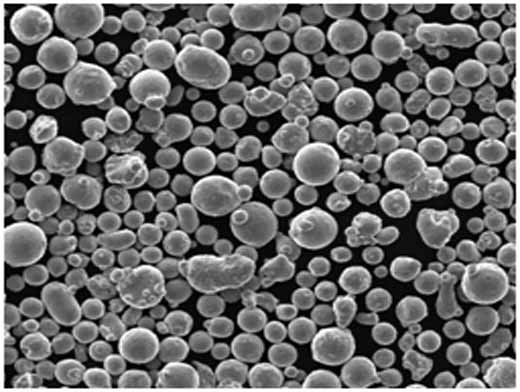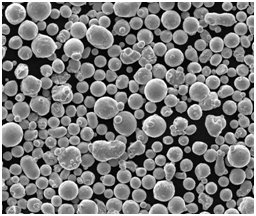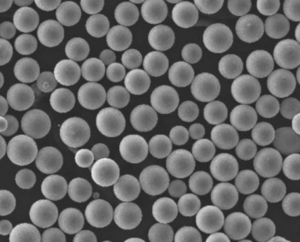Wenn es um Hochleistungslegierungen geht, die in extremen Umgebungen eingesetzt werden, Haynes 188 Pulver zeichnet sich als führende Wahl aus. Ganz gleich, ob Sie in der Luft- und Raumfahrt, in der Energieerzeugung oder in einer anderen Branche arbeiten, in der Materialien benötigt werden, die extremer Hitze standhalten, Haynes 188 Pulver ist bekannt für seine Hitzebeständigkeit, Oxidationsbeständigkeit und Kriechfestigkeit. Aber was macht dieses Pulver wirklich einzigartig, und warum sollten Sie es für Ihr nächstes Hochtemperaturprojekt in Betracht ziehen?
In diesem umfassenden Leitfaden erfahren Sie alles, was Sie über Haynes 188 Powder wissen müssen. Wir werden seine Zusammensetzung, Eigenschaften und Anwendungen untersuchen und es sogar mit anderen beliebten Metallpulvern vergleichen. Also, schnallen Sie sich an und lassen Sie uns in die Welt der Superlegierungen auf Kobaltbasis eintauchen.
Überblick über Haynes 188 Powder
Haynes 188 Powder ist eine Superlegierung auf Kobaltbasis, die für ihre hervorragende Hochtemperaturleistung bekannt ist. Sie wird häufig in Umgebungen eingesetzt, in denen Oxidationsbeständigkeit und thermische Stabilität entscheidend sind. Die Pulverform von Haynes 188 eignet sich ideal für die additive Fertigung und ermöglicht die einfache Herstellung komplizierter Formen und Komponenten.
Schlüsselattribute:
- Ausgezeichnete Oxidationsbeständigkeit bis zu 1095°C (2000°F)
- Gute Hochtemperaturfestigkeit
- Hervorragender Widerstand gegen thermische Ermüdung
- Hervorragende Kriech- und Oxidationsbeständigkeit
- Ideal für Luft- und Raumfahrt, Gasturbinen und Brennkammerauskleidungen
Häufige Verwendungen:
- Komponenten für die Luft- und Raumfahrt wie Brennkammern und Nachverbrennungsanlagen
- Stromerzeugung Anwendungen
- Industrieöfen und Wärmedämmschichten

Zusammensetzung von Haynes 188-Pulver
Der Schlüssel zum Verständnis, warum Haynes 188 Powder so gut funktioniert, liegt in seiner Zusammensetzung. Diese Legierung auf Kobaltbasis wurde speziell entwickelt, um extremen Umweltbedingungen zu widerstehen.
| Element | Zusammensetzung (%) |
|---|---|
| Kobalt (Co) | Waage |
| Chrom (Cr) | 22.0 |
| Nickel (Ni) | 22.0 |
| Tungsten (W) | 14.0 |
| Lanthan (La) | 0.03 |
| Kohlenstoff (C) | 0.10 |
| Silizium (Si) | 0.35 |
| Manganese (Mn) | 1.25 |
Was macht diese Komposition so besonders?
- Chrom erhöht die Oxidations- und Korrosionsbeständigkeit des Materials.
- Nickel verbessert die Gesamtstabilität der Legierung bei hohen Temperaturen.
- Tungsten erhöht die Festigkeit, insbesondere bei Anwendungen mit hoher Hitzeentwicklung.
- Lanthan erhöht die Oxidationsbeständigkeit und trägt zur Langlebigkeit der Legierung bei.
Jedes Element ist strategisch so gewählt, dass Haynes 188 Powder vor allem in extremen Umgebungen eine hohe Leistungsfähigkeit aufweist.
Merkmale von Haynes 188-Pulver
Nachdem wir nun wissen, was in Haynes 188 Powder steckt, wollen wir uns das Pulver ansehen physikalische und mechanische Eigenschaften.
| Eigentum | Wert |
|---|---|
| Schmelzbereich | 1330°C – 1410°C |
| Dichte | 8.90 g/cm³ |
| Zugfestigkeit bei Raumtemperatur | 895 MPa (130 ksi) |
| Streckgrenze bei Raumtemperatur | 430 MPa (62 ksi) |
| Dehnung | 45% |
| Härte (Rockwell C) | 24 |
| Wärmeausdehnungskoeffizient | 12.8 μm/m°C (bis zu 800°C) |
| Wärmeleitfähigkeit | 10.7 W/m-K |
| Oxidationsbeständigkeit | Bis zu 1095°C |
Bemerkenswerte Merkmale:
- Hohe Festigkeit und Duktilität: Bietet eine überragende mechanische Festigkeit in Kombination mit einer ausgezeichneten Duktilität und eignet sich daher ideal für Teile, die hohen Belastungen ausgesetzt sind.
- Thermische Stabilität: Hält extremen Temperaturen stand, ohne seine mechanische Integrität zu verlieren.
- Kriechstromfestigkeit: Die ausgezeichnete Kriechfestigkeit gewährleistet, dass die Legierung auch bei längerer Hitzeeinwirkung ihre Form behält.
Anwendungen von Haynes 188 Pulver
Dank seiner bemerkenswerten Eigenschaften ist Haynes 188 Powder die erste Wahl in Branchen, in denen Hitzebeständigkeit und Oxidationsschutz von größter Bedeutung sind. Sehen wir uns die spezifischen Branchen und Anwendungen an, in denen diese Superlegierung wirklich glänzt.
| Anmeldung | Einzelheiten |
|---|---|
| Luft- und Raumfahrt | Brennkammern, Nachverbrennungsanlagen, Abgasdüsen, Gasturbinen |
| Stromerzeugung | Gasturbinenschaufeln, Heißgaswege, Verbrennungsauskleidungen |
| Industrieöfen | Komponenten, die hohen Temperaturen und oxidativen Umgebungen ausgesetzt sind |
| Additive Fertigung (3D-Druck) | Herstellung komplexer Formen für Anwendungen in der Luft- und Raumfahrt und der Energieerzeugung |
| Chemische Verarbeitung | Wärmetauscher, Reaktoren und andere Geräte in korrosiven Umgebungen |
In der Luft- und Raumfahrtindustrie wird Haynes 188 Powder häufig für die Herstellung von Brennkammern und Turbinensektionen von Flugzeugtriebwerken verwendet. Auch in Kraftwerken wird diese Superlegierung wegen ihrer ausgezeichneten Hitzebeständigkeit häufig verwendet.
Additive Fertigung:
Einer der wichtigsten Vorteile von Haynes 188 in Pulverform ist seine Anpassungsfähigkeit an die additive Fertigung oder den 3D-Druck. Dies ermöglicht die Herstellung komplizierter, hochleistungsfähiger Teile mit minimalem Abfall, was sie sowohl kosteneffizient als auch umweltfreundlich macht.






Beliebte Modelle mit Metallpulver: Haynes 188 Pulver und Alternativen
Vergleichen wir Haynes 188 mit anderen gängigen Metallpulvermodellen, die häufig bei Hochtemperaturanwendungen eingesetzt werden.
| Metall-Pulver | Zusammensetzung | Bemerkenswerte Eigenschaften | Anwendungen |
|---|---|---|---|
| Haynes 188 | Co, Cr, Ni, W, La | Hohe Hitzebeständigkeit, Oxidationsbeständigkeit | Luft- und Raumfahrt, Energieerzeugung, Öfen |
| Inconel 625 | Ni, Cr, Mo, Nb | Ausgezeichnete Korrosions- und Oxidationsbeständigkeit | Marine, chemische Verarbeitung, Kernreaktoren |
| Inconel 718 | Ni, Cr, Mo, Fe | Hohe Festigkeit, Ermüdungsfestigkeit und Kriechbeständigkeit bei hohen Temperaturen | Düsentriebwerke, Raumfahrzeuge, Turbinen |
| Haynes 230 | Co, Cr, W, Mo | Gute thermische Stabilität, Oxidationsbeständigkeit bis zu 1200°C | Luft- und Raumfahrt, chemische Verarbeitung, Kraftwerke |
| Haynes 282 | Ni, Cr, Mo, Ti | Ausgezeichnete Schweißbarkeit und thermische Stabilität | Gasturbinen, Verbrennungsauskleidungen |
| Hastelloy X | Ni, Cr, Fe, Mo, Co | Hohe Oxidationsbeständigkeit und gute Verformbarkeit | Triebwerkskomponenten, Ofenanwendungen |
| Wolframkarbid (WC) | W, C | Extreme Härte, hoher Schmelzpunkt | Schneidwerkzeuge, verschleißfeste Anwendungen |
| Nickel 625-Pulver | Ni, Cr, Mo, Nb | Hohe Korrosionsbeständigkeit, Schweißbarkeit | Chemische Verarbeitung, Schiffsindustrie |
| Stellit 6B | Co, Cr, W, Mo | Ausgezeichnete Verschleißfestigkeit, Zähigkeit | Schneidwerkzeuge, Sägeblätter, Verschleißteile |
| Kobalt Chrom | Co, Cr | Hohe Verschleißfestigkeit, Biokompatibilität | Medizinische Implantate, zahnmedizinische Anwendungen |
Vorteile von Haynes 188 Powder
Haynes 188 Powder hat viele Vorteile gegenüber anderen Hochleistungsmetallpulvern. Schauen wir uns genauer an, was es zur besten Wahl unter extremen Bedingungen macht.
1. Hochtemperaturfestigkeit
Im Vergleich zu anderen Legierungen zeichnet sich Haynes 188 dadurch aus, dass es auch bei extremer Hitze seine Festigkeit behält. Während einige Werkstoffe bei hohen Temperaturen weich werden, hält Haynes 188 einem Dauerbetrieb bei bis zu 1095 °C stand.
2. Oxidationsbeständigkeit
Der hohe Chrom- und Nickelgehalt der Legierung verleiht ihr eine ausgezeichnete Oxidationsbeständigkeit, selbst in extremen Umgebungen. Dies ist von entscheidender Bedeutung in Branchen wie der Luft- und Raumfahrt und der Energieerzeugung, wo die Komponenten sauerstoffreichen Atmosphären bei hohen Temperaturen ausgesetzt sind.
3. Kriechwiderstand
Im Vergleich zu anderen Superlegierungen wie Inconel 625 oder Hastelloy Xhaynes 188 zeigt besser kriechstromfestigkeit. Das bedeutet, dass die Legierung ihre strukturelle Integrität auch bei langfristiger Belastung durch hohe Temperaturen beibehält.
4. Vielseitigkeit in der additiven Fertigung
Als Pulver ist Haynes 188 besonders geeignet für 3D-Druckund ermöglicht die Herstellung komplexer, hochpräziser Teile mit minimalem Ausschuss.
Beschränkungen der Haynes 188 Pulver
Natürlich ist kein Material perfekt. Lassen Sie uns einige der möglichen Einschränkungen von Haynes 188 Powder untersuchen.
1. Kosten
Einer der größten Nachteile von Haynes 188-Pulver sind seine Kosten. Das Vorhandensein von Kobalt und Wolfram macht es relativ teurer als andere Superlegierungen wie Inconel 718. Allerdings rechtfertigen die Langlebigkeit und die Leistungsvorteile oft den höheren Preis.
2. Schweißeignung
Haynes 188 kann zwar geschweißt werden, ist aber nicht so gut schweißbar wie einige andere Nickelbasislegierungen
wie Inconel 625. Dies kann bei Anwendungen, die viele Schweißarbeiten erfordern, eine Herausforderung darstellen.
3. Begrenzte Korrosionsbeständigkeit
Obwohl Haynes 188 bei hohen Temperaturen außerordentlich gut abschneidet, ist es nicht so korrosionsbeständig wie andere Legierungen wie Hastelloy X, insbesondere in marinen oder stark säurehaltigen Umgebungen.
Spezifikationen, Größen, Güteklassen und Normen für Haynes 188-Pulver
Hier sind einige der wichtigsten Spezifikationen und Normen im Zusammenhang mit Haynes 188 Pulver.
| Spezifikation | Einzelheiten |
|---|---|
| Dichte | 8.90 g/cm³ |
| Schmelzbereich | 1330°C – 1410°C |
| Standardgrößen | Erhältlich in einer Vielzahl von Maschenweiten für den 3D-Druck |
| ASTM-Normen | ASTM F75, ASTM B637 |
| Typische Qualitäten | AMS 5608, AMS 5801, AMS 5943 |
| Anwendbare Normen | ISO 9001:2015, AS 9100D, NADCAP |
Lieferanten und Preisangaben für Haynes 188-Pulver
Bei der Beschaffung von Haynes-Pulver 188 ist es wichtig, auf Folgendes zu achten seriöse Anbieter um sicherzustellen, dass Sie ein hochwertiges Produkt erhalten. Nachfolgend finden Sie einige bekannte Anbieter sowie eine ungefähre Preisspanne.
| Anbieter | Preisspanne (USD/kg) | Region | Zertifizierung |
|---|---|---|---|
| Tischlertechnik | $150 – $300 | USA | ISO 9001, AS 9100, NADCAP |
| Hoganas | $180 – $320 | Europa, Global | ISO 9001, AS 9100 |
| Praxair | $170 – $280 | USA, weltweit | ISO 9001, NADCAP |
| EOS | $200 – $350 | Deutschland, Global | ISO 9001 |
| Kennametal | $160 – $310 | USA | AS 9100, ISO 14001 |
Die Preise variieren je nach Faktoren wie Reinheit, Partikelgrößeund lieferantenzertifizierungen. Bei größeren Bestellungen werden in der Regel Preisnachlässe gewährt, und zusätzliche Dienstleistungen wie kundenspezifisches Mischen oder Maschenweiten können den Preis erhöhen.
Vor- und Nachteile von Haynes 188 Powder
Bei der Entscheidung darüber, ob Haynes 188 Pulver das richtige Material für Ihr Projekt ist, ist es wichtig, die Vor- und Nachteile abzuwägen.
| Profis | Nachteile |
|---|---|
| Außergewöhnliche Hitze- und Oxidationsbeständigkeit | Relativ teuer im Vergleich zu anderen |
| Stark bei hohen Temperaturen | Begrenzte Korrosionsbeständigkeit |
| Kriechstromfest | Die Schweißbarkeit ist nicht so einfach wie bei einigen anderen Legierungen |
| Ideal für die additive Fertigung | Erfordert aus Kostengründen eine spezielle Handhabung und Verarbeitung |

FAQs
Hier finden Sie einen kurzen Abschnitt mit häufig gestellten Fragen (FAQ), um einige der häufigsten Fragen zu Haynes 188 Powder zu beantworten.
| Frage | Antwort |
|---|---|
| Wofür wird Haynes 188-Pulver verwendet? | Es wird in der Luft- und Raumfahrt, bei der Energieerzeugung und in Industrieöfen verwendet, vor allem für Hochtemperaturkomponenten. |
| Wie sieht es im Vergleich zu Inconel 625 aus? | Haynes 188 bietet eine bessere Kriechfestigkeit bei hohen Temperaturen, während Inconel 625 eine bessere Korrosionsbeständigkeit aufweist. |
| Kann Haynes 188-Pulver in 3D gedruckt werden? | Ja, Haynes 188-Pulver wird häufig in der additiven Fertigung für komplexe, hitzebeständige Teile verwendet. |
| Ist Haynes 188 Powder teuer? | Ja, aufgrund seiner Zusammensetzung (hoher Kobalt- und Wolframgehalt) ist es im Allgemeinen teurer als andere Superlegierungen. |
| Welche Temperatur kann Haynes 188 aushalten? | Es kann Temperaturen bis zu 1095°C (2000°F) standhalten und ist damit für extreme Umgebungen geeignet. |
| Ist Haynes 188 leicht zu schweißen? | Es kann zwar geschweißt werden, ist aber nicht so leicht zu schweißen wie andere Nickelbasislegierungen wie Inconel 625. |
| Wo kann ich Haynes 188-Pulver kaufen? | Sie können es von Anbietern wie Carpenter Technology, Höganäs und EOS kaufen. Die Preise variieren je nach Anbieter und Bestellmenge. |

